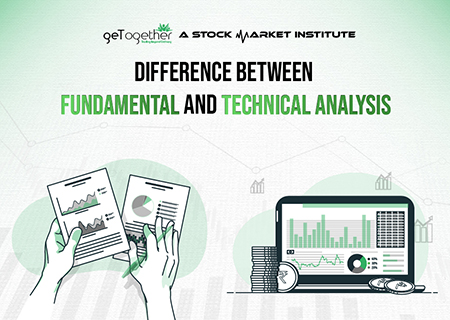Difference Between Fundamental and Technical Analysis


Investing in the stock market can give potential profits but also be challenging at the same time, specifically for those who have just started their trading journey. One of the most crucial choices investors must make is whether to use fundamental or technical analysis considering their financial goals, risk appetite, and time horizon. In this article we will discuss selecting the method that is most suitable for you, we will go over the primary difference between fundamental and technical analysis.
Table of Contents
ToggleIntroduction
Fundamental and technical analysis are the two most common methods for analyzing the stock market. To decide a stock’s intrinsic value or real value, fundamental analysis looks at the company’s business model, such as profit loss reports, balance sheets, and financial reports. To predict how prices will move in the future, technical analysis looks at demand and supply market trends and charts.
What’s the process of technical analysis?
Technical analysis is used to predict the future price action of stocks by looking at historical data. By analyzing demand and supply you get the origin of the whole rally, with market trends to find the best stocks to invest in, and by using indicators like moving averages, and the relative strength index (RSI) you get entry and exit points. In addition, a top-down approach, multiple time frame analysis, and risk management for minimizing the risk are included in the technical analysis.
What is the process of Fundamental Analysis?
The fundamental analysis examines the stock’s underlying value by examining the company’s overall business model. Fundamental analysts look at a company’s quarterly results, income statements, balance sheets, and cash flow statements to determine whether it is undervalued or overvalued.
TECHNICAL VS FUNDAMENTAL ANALYSIS

Although the goals of both fundamental and technical analysis are to assist investors in making better investment decisions, there are several ways in which they differ from one another.
1. Comparing fundamental and technical analysis , stocks are analyzed over longer periods in fundamental analysis. Investors who want to invest in stocks whose value will rise over time, therefore, employ fundamental analysis. On the other hand, when the trade is only for the short term, technical analysis is used.
2. The time difference between fundamental and technical analysis can also be seen in financial objectives, as the technical analysis focuses on trading while the fundamental analysis focuses on investing. Since traders rely on technical analysis to make short-term profits, fundamental analysis is used by the majority of investors to buy or hold company stocks.
3. Technical analysis is used to determine when to enter or exit the market i.e. demand and supply, whereas fundamental analysis aims to determine the true intrinsic value of the stock.
4. Decision-making in fundamental analysis is based on statistical evaluation of the available data of the company. In contrast, in technical analysis, market trends and the stock price are used to make decisions.
5. Technical analysis only takes into account data from the past to predict future price action, whereas fundamental analysis takes into account both past and present data.
6. Financial statements serve as the foundation for fundamental analysis, whereas price movement charts serve as the foundation for technical analysis.
7. An income statement, balance sheet, cash flow statement, profit margin, return on equity, price-to-earnings ratio, and other financial statements can all be examined in fundamental analysis to determine the stock’s intrinsic value. However, in order to analyze future price trends, technical analysts rely on demand and supply, price actions, technical indicators, resistance, and support, as well as chart patterns (such as continuation patterns and reverse patterns). Resistance is the point at which an investor believes the price will not rise any further and is prepared to sell; Support is the point at which an investor believes the price will not fall any further and is prepared to buy.
8. Long-term positional traders conduct fundamental analysis, while swing traders and short-term day traders conduct technical analysis.
The Main Tools for Technical Analysis

To analyze the price action of a stock, technical analysis is an advanced form which conveys each and every information to the investor or a trader through the charts. Technical analysis works depending on some important tools like:
Moving Averages: These are the indicators over the price charts which determine the average price of the asset across a defined period. It can be observed on various timeframes like daily, weekly, monthly or intraday.
Trend Line: Trend lines are formed on the chart through pivot highs or lows indicating the follow up of a single trend.
Support and Resistance Level: It identifies the level from which the prices have rebounded or rejected typically in the past and has the ability to bounce back again or get rejected with an increase in number of buyers or sellers. Buyers are strong at the support level while selling pressure is high at resistance level.
Chart Patterns: For an effective technical analysis, chart patterns are analyzed by traders by drawing triangles or several geometric shapes on the price charts. There are multiple chart patterns like horizontal channel, cup and handle chart pattern, double top and bottom chart pattern, etc.
Demand and Supply Theory: In candlesticks charts, demand zones and supply zones are created within the price action. Analyzing the zones with top down approach, multiple time frame analysis, sector support, EMA support and other technical factors is an advanced technical analysis concept for traders and investors.
The Main Tools of Fundamental Analysis

To invest in the stock market, a fundamental approach is undertaken to ascertain the actual value of the stock and make investment decisions. Some important tools for determination of stock prices are:
Company Analysis: A company’s actual value is realized through the data like balance sheet, financial statement, cash flow statement, ratios and metrics, management quality, competitors, etc.
Macroeconomic Tools: In a broad analysis, economic indicators like GDP growth, inflation rates, unemployment rates, interest rates and government fiscal policies provide a sense of overall economic environment. Examining industry trends, competitive landscape, and overall regulatory environment of the industry is analyzed to understand overall growth prospects of the industry.
Internal and External Factors: Fundamental analysis include thorough study of the business model, brand strength, corporate governance, regulatory environment, market conditions, political stability, technological changes, and social and environmental factors.
Criticisms of Fundamental Analysis

Fundamental analysis might be very efficient for investors in the long term but it is subjective to certain criticisms and hence an investor must be aware of those practices to gain better understanding.
To analyze the business in detail is extraordinarily time consuming which might in fact not always work in the favor of an investor.
Valuation techniques may vary depending on the company or industry which can limit the research while complicating it. Also, due to subjectivity, each investor might have a different perspective of valuing the company.
Also Read: Risk Management
The Pros and Cons of Fundamental and Technical Analysis

Pros and Cons of Fundamental Analysis
Pros:
Long Term Wealth Creation: Fundamental analysis is mainly suitable for investors who are looking for term growth opportunities.
Informed Decision Making: Investors can make well informed decisions based on the company’s financial health and economic conditions.
Cons:
Time Consuming: Reviewing financial statements of the company requires a lot of time with a significant amount of research and data analysis.
Pros and Cons of Technical Analysis
Pros:
Easy to Understand: Unlike fundamental analysis, technical analysis provides clear trading rules and is much easier to understand the relationship between the price and the indicator.
Short Term Movements: Short term movement can also be easily predicted through price action and technical indicators.
Cons:
Market Volatility: Volatile nature of market is always a discomfort for traders as it might negatively impact an investor’s portfolio
CONCLUSION
The two primary approaches to analyzing the stock market are fundamental and technical analysis. While stock price and volume data are the focus of technical analysis, fundamental analysis focuses on the company’s financial statements. Both approaches have advantages and disadvantages, and which one you choose ultimately depends on your preferences and investment goals. numerous traders and investors employ a combination of the two to arrive at well-informed decisions.
FAQs
1. Can fundamental and technical analysis be used in conjunction?
Yes, a lot of investors combine both the fundamental and technical analysis to get a more complete picture of a stock’s potential.
2. Which is more accurate, fundamental analysis or technical analysis?
The accuracy of stock performance predictions cannot be guaranteed by either approach. Both fundamental and technical analysis are constrained and rely on data interpretations and assumptions.
3. Is technical analysis appropriate for investing over the long term?
Technical analysis is best used for short-term trading, but some long-term investors also incorporate it into their investment plans.
4. Can I learn technical analysis without having any prior stock market experience?
Yes, for learning technical analysis you do not need to have prior experience with practice and education, anyone can learn technical analysis. Getting started with technical analysis can be made easier with the help of numerous stock market courses available online which are easily accessible.
5. For beginners is Fundamental analysis better or technical analysis better?
It depends on the individual’s preferences and investment objectives to choose between fundamental and technical analysis. While some novices may prefer technical analysis, others may find fundamental analysis easier to understand. It is essential to decide your goals before selecting the one that best suits your investment style.
CATEGORIES



 Facebook
Facebook Instagram
Instagram Youtube
Youtube
